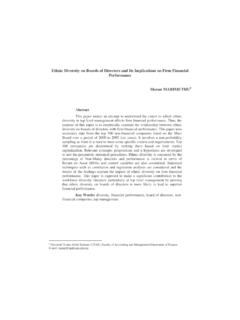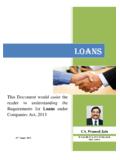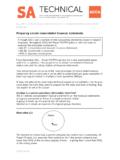Transcription of Publication 5137 (01-2014) - irs.gov
1 January 2014. Publication 5137 (1-2014) Catalog Number 66216W Department of the Treasury Internal Revenue Service TABLE OF CONTENTS. 1 Introduction 2 Reporting and Withholding on Fringe Benefits 3 Working Condition Fringe Benefits 4 De Minimis Fringe Benefits 5 No-Additional-Cost Fringe Benefits 6 Qualified Employee Discounts 7 Qualified Transportation Fringe Benefits (QTF). 8 Health and Medical Benefits 9 Travel Expenses 10 Transportation Expenses 11 Moving Expenses 12 Meals and Lodging 13 Reimbursements for Use of Employee-Owned Vehicles 14 Employer-Provided Vehicles 15 Equipment and Allowances 16 Awards and Prizes 17 Professional Licenses and Dues 18 Educational Reimbursements and Allowances 19 Dependent Care Assistance 20 Group-Term Life Insurance 21 Fringe Benefits for Volunteers 22 Fringe Benefits for Independent Contractors Appendix: Contact Information INDEX.
2 2. 1 Introduction The Taxable Fringe Benefits Guide was created by the Internal Revenue Service office of Federal, State and Local Governments (FSLG) to provide governmental entities with a basic reference guide to Federal tax rules relating to employee fringe benefits and reporting. As a supplement to other IRS publications, the Taxable Fringe Benefit Guide is designed to help individuals responsible for determining the correct tax treatment of employee fringe benefits and the appropriate withholding and reporting procedures for them. This Publication covers: How to determine whether specific types of benefits or compensation are taxable. Procedures for computing the taxable value of fringe benefits. Rules for withholding Federal income tax, social security, and Medicare taxes from taxable fringe benefits.
3 Reporting of the taxable value of benefits on Forms W-2 and 1099- MISC. How to contact the Internal Revenue Service with questions regarding taxation and reporting requirements. NOTICE. This guide is intended to provide basic information on the tax treatment of fringe benefits. It reflects the interpretation by the IRS. of tax laws, regulations, and court decisions. The explanations in the guide are intended for general guidance only, and are not intended to provide a specific legal determination with respect to a particular set of circumstances. Additional research may be required before a determination may be made on a particular issue. Citations to legal authority are included in the text. You may contact the IRS for additional information.
4 You may also want to consult a tax advisor to address your situation. What Is a Fringe Benefit? A fringe benefit is a form of pay (including property, services, cash or cash equivalent), in addition to stated pay, for the performance of services. Under Internal Revenue Code section 61, all income is taxable unless an exclusion applies. Some forms of additional compensation are specifically designated as fringe benefits in the Internal Revenue Code; others, such as moving expenses or awards, are addressed by statutory 3. provisions providing for special tax treatment, but are not designated as fringe benefits by the Code. This Publication uses the term fringe benefit broadly to refer to all remuneration other than stated pay for which special tax treatment is available.
5 The definition of fringe benefits for this purpose generally applies to services of independent contractors as well as employees; however, unless otherwise indicated, this guide applies to fringe benefits provided by an employer to an employee. (For a discussion of whether a worker is an employee or independent contractor, see Publication 15-A.). Fringe benefits for employees are taxable wages unless specifically excluded by a section of the Internal Revenue Code (IRC). IRC 61 IRC 3121, 3401; IRC 61(a)(1). More than one IRC section may apply to the same benefit. For example, education expenses up to $5,250 may be excluded from tax under IRC section 127. Amounts for additional education expenses exceeding $5,250 may be excluded from tax under IRC.
6 Section 132. A benefit provided on behalf of an employee is taxable to an employee even if the benefit is received by someone other than the employee, such as a spouse or a child. Reg. (a)(4). Types of Tax Treatment of Fringe Benefits The IRC may provide that a fringe benefit is nontaxable, partially taxable, or tax- deferred. These terms are defined below. Taxable Includible in gross income, not excluded under any IRC section. If the recipient is an employee, this amount is includible as wages and reported on Form W-2, Wage and Tax Statement, and generally is subject to Federal income tax withholding, social security (unless the employee has already reached the current year social security wage base limit), and Medicare.
7 For example, bonuses are always taxable because they are income under section 61 and no IRC section excludes them from taxation. Fringe benefits that do not meet any statutory requirements for exclusion are fully taxable. Although there are special rules and elections for certain benefits, in general, taxable fringe benefits are reported as wages on Form W-2 for the year in which the employee received them. No tax reporting is required for benefits that meet the accountable plan rules, discussed below. IRC 451(a); IRS Ann. 85-113, 1985-31. If an employee's wages are not normally subject to social security or Medicare taxes (for example, because the employee is covered by a qualifying public retirement system), these taxes would not apply to fringe benefits the employee received.
8 However, the value of the benefits is reportable for income tax withholding purposes. 4. Nontaxable (excludable) Excluded from wages by a specific IRC section; for example, qualified health plan benefits excludable under section 105. Partially taxable - Part is excluded by IRC section and part is taxable. Benefits may be excludable up to dollar limits, such as the public transportation subsidy under section 132. Tax-deferred Benefit is not taxable when received, but subject to tax later. For example, employer contributions to an employee's pension plan may not be taxable when made, but may be taxed when distributions are made to the employee. General Valuation Rule Generally, taxable fringe benefits are included in wages at their fair market value (FMV).
9 FMV is the amount a willing buyer would pay an unrelated willing seller, neither one forced to conduct the transaction and both having reasonable knowledge of the facts. In many cases, the cost and FMV are the same; however, there are many situations in which FMV and cost differ, such as when the employer incurs a cost less than the value to provide the benefit. Reg. (b). The taxable amount of a benefit is reduced by any amount paid by or for the employee. For example, an employee has a taxable fringe benefit with a fair market value of $ per day. If the employee pays $ per day for the benefit, the taxable fringe benefit is $ per day. Special valuation rules apply for certain fringe benefits. These rules are covered in other sections.
10 IRC Sections Excluding Fringe Benefits The following Code sections provide a statutory basis for specific benefits that may apply to public employees. Each is discussed later in the text. 105 Benefits received through employer health or accident insurance 106 Health insurance premiums paid by employer 117(d) - Qualified tuition reductions 119 - Meals or lodging provided for the employer's convenience 125 - Cafeteria plans 127 - Educational assistance program 129 - Dependent care assistance program 132(b) - No additional-cost service 132(c) - Qualified employee discounts 132(d) - Working condition fringe 132(e) - De minimis benefit 5. 132(f) - Qualified transportation fringe 132(g) - Qualified moving expense reimbursements 132(j)(4) - On-premises athletic facilities 132(m) - Qualified retirement planning services 132(n) Qualified military base realignment and closure fringe 137 Adoption assistance programs 6.

















